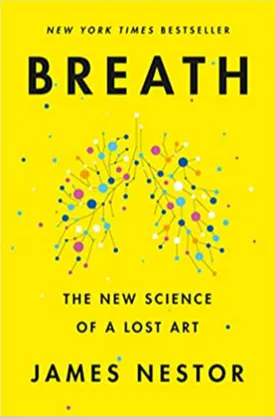Breath: The New Science of a Lost Art by James Nestor
The growing awareness and conversations around the way we breathe is continuing to expand with the recent release of 'Breath: The New Science of a Lost Art' by James Nestor. In this book, Nestor takes a deep dive into the many benefits of proper breathing practices and how this age-old technique can help people improve their physical, cognitive, and emotional health.
Nestor begins by providing us with an overview of the current state of breath sciences, a field that is said to be in relative infancy. He divides the book into three main parts, starting with ‘The Oxygen Revolution’. Here, the reader is taken on a journey to understand the basics of breath physiology and learn about the importance of good breathing habits.
In the second part of the book, Nestor reveals the miracles of breath, exploring the various avenues of modern science while also shedding light on how historically apprenticed breath practices connect us with our environment in ways few of us are aware of. Finally, the conclusion of the book provides readers with a wide range of tools – tools including mouthwashes, yoga, and qigong breathing exercises – that can help anyone to optimize their breathing and therefore improve overall wellness.
At the heart of Nestor's thesis is the notion that proper breath regulation brings improved wellbeing and better quality of life. His argument is primarily focused on the oxygen-rich benefits of deep belly breathing, which allows for a prolonged inhalation and full exhalation. This fully oxygenated breath, as Nestor explains, brings a host of positive physical, neurological, and emotional benefits, from lowered levels of stress, decreased muscular pain, and improved concentration, to enhanced creativity and overall wellbeing.
In addition to providing scientific studies and research to back up his thesis, Nestor also has stories from his own personal journey and the journey of others, to support his claims about the power of breath. He recounts some stories of people with extreme health problems such as asthma, depression, and even COVID-19, who were able to use breathing practices as a means to recovery. This section of the book is particularly transformative and inspiring, drawing on the lessons found in traditional breath practices to further validate the science behind how breath can be used to improve human health.
Overall, 'Breath: The New Science of a Lost Art' is an excellent book that will capture the attention of both the scientist and the yoga practitioner alike. For those looking to gain insight into the importance of proper breath regulation and better understand how it can be used for improving health, this book is essential reading. Moreover, Nestor does an excellent job at making the science and traditional practices of breath approachable and provides a comprehensive guide that empowers readers to utilize the power of their breath to take control of their overall wellbeing.

